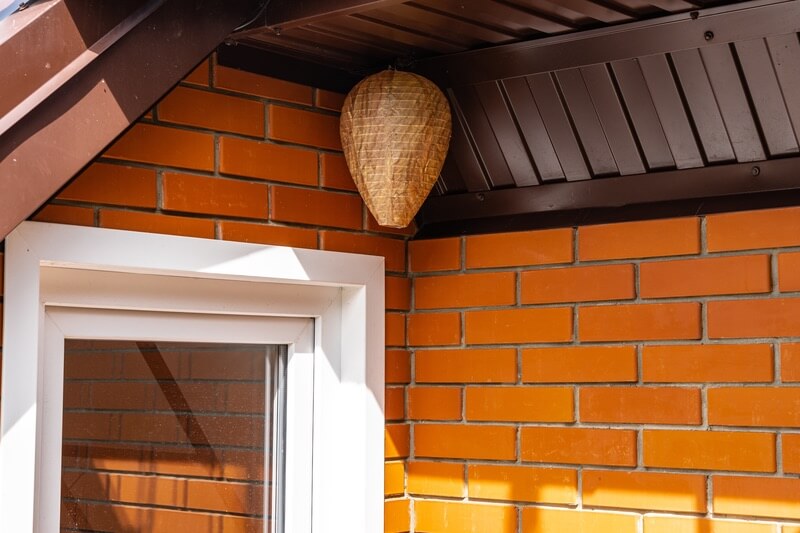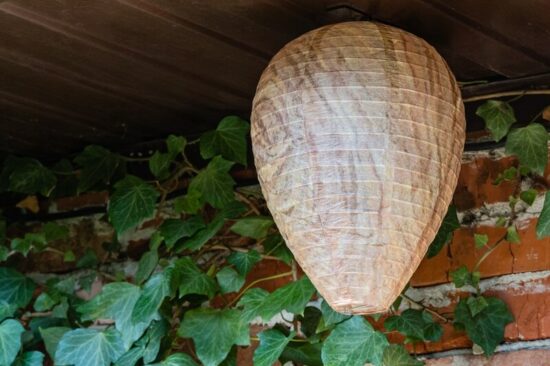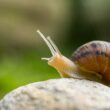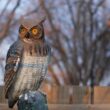Fake wasp nests are interesting pest control products that many homeowners consider at some point.
But do they actually work?
This guide will break down the effectiveness of these decoy wasp nests, and what you should do if you want to see results.
Table of Contents
What Are Fake Wasp Nests?
Wasps are the bane of summertime afternoon fun! While these stinging pests usually mind their own business and don’t sting unless bothered, they can still cause tons of trouble in your backyard. The insects have a knack for stinging curious pets and children.
If left alone, wasps can create massive nests and build colony numbers into their hundreds! Once a nest gets to that point, it becomes a serious threat to your family’s safety and well-being.
Ideally, you’d want to deter these flying demons from setting up shop anywhere close to where you and your family spend time outside. Unfortunately, catching wasps building their nests early isn’t always possible. In most cases, you find the nest once it’s established and risky to eliminate on your own.

That’s why so many homeowners go to great lengths to prevent these insects from establishing a nest in the first place.
That’s where fake wasp nests come in.
A fake wasp nest is a human-made replication of those menacing nests you see the stinging bugs swarming around. Real wasps nests are a thing of haunting beauty. They’re impressive structures that potentially hundreds of wasps will work together to create.
But inside, there’s a growing colony of young and a queen hell-bent on building colony numbers. Nests will continue to grow as more young wasps reach maturity, and the life cycle restarts with an entirely new generation.
Fake wasp nests aren’t super detailed, nor are they capable of supporting an actual wasp nest. Instead, they’re simple decoys typically made of wire and paper. Craftier models may have a paper-mâché texture for a closer-to-life look, but most fake wasp nests are nothing more than oddly shaped paper lanterns.
The nests fold flat, unfurl to take on that iconic oblong shape, and have a similar brown color. You can hand them up pretty much anywhere, and many homeowners get a collection of them to dot porches and sheds.
But what do they do?
These decoy wasp nests are supposed to prevent these insects from establishing a colony nearby. Wasps are notoriously territorial. That’s why they often go on the offensive when you venture too close to a nest.
They want to protect their young and the queen. The insects do their best to set up nests in places that are safe, out of the way, and not occupied by other creatures. It’s believed that they don’t like to make nests near other established colonies.
Some experts say they stay at least 200 feet from existing nests to avoid confusion and constant clashing with nearby rivals.
Fake wasp nests are supposed to deter these pests by taking advantage of their territorial nature. You’re supposed to place several nests around porches, decks, and other enticing structures. The hope is that queen wasps fresh out of hibernation will see the decoy and think that there’s already a colony in the area.
Ideally, she’ll think that the space is too crowded already. In turn, she will establish a colony elsewhere. Many homeowners will place many fake wasps nests around their property as a safety measure. It’s not uncommon to see these little brown lanterns hanging from structures all over wasp-prone backyards.
Do Fake Wasp Nests Work?
Here’s the million-dollar question: do fake wasp nests work? You’ll hear people swear up and down that they work wonders to keep wasps off their property. However, you’ll also encounter folks who say they’re nothing more than a scam!
So which is it?
The reality is that fake wasp nests can be hit or miss. There’s no doubt that some fake wasp nests have served their purpose, but there’s no hard evidence to support that they are consistently effective.
The evidence is anecdotal at best. No peer-reviewed studies of decoy wasp nests exist (which isn’t surprising). That’s not to say that they can’t work. But until researchers clear things up with evidence, it’s hard to say that they work using.
Many of the fake wasp nests you encounter on the market today look pretty good and eerily authentic, but there’s just one problem:
Not all wasp species use the same type of nest.
Traditionally faux nests are shaped like an oval. They have a signature egg-like shape that you see hornets use. But what if you’re not dealing with bald-faced hornets?
Mud daubers don’t use those types of nests. They create tube-like structures on walls and ceilings. And what about paper wasps? These creatures are widespread and create dome-shaped nests with visible cells.
In those cases, the fake hornet nest would be pretty useless. Even the most well-made fake nest won’t serve much purpose if you don’t have hornets invading your property.
On top of all that, there’s the issue of wasps’ so-called territorial nature. Wasps are indeed territorial. Anyone who’s experienced a sting for simply getting too close to a nest will tell you that!
But do wasps mind being near other nests? That’s up for debate. There are many instances of separate nests being only a few feet from one another.
In those cases, the colonies coexist without any issues. Seeing two wasp nests in relatively close quarters suggests that the science behind why fake nests work isn’t entirely accurate.
Expert Tip: There’s still a lot to learn about wasps and their unique behavior. While some people might see success with fake wasp nests, there are no guarantees. It’s still worth a shop if you want a simple alternative to wasp control, but don’t be too surprised if those flying pests still come around.,
Where Should You Hang Them?
If you decide to give fake wasps nests a try, the first thing you’ll have to do is figure out where to place them. Nest decoys are relatively straightforward. The lantern-like design makes them easy to hang from anywhere with a pin or nail.
Your best bet is to look around and note where wasps like to hang out in your yard. If you’ve encountered them before, you might notice that they gravitate to a specific area. That’s the first place you should hang the fake nest!
Wasps love to set up nests in discrete areas that don’t have a ton of traffic. It might be high up out of the way from humans, animals, and other insects.
Look around for overhangs and eaves. Wasps tend to find relatively cool spots with shade and protection from the elements. You might consider placing fake nests around porch overhangs, pergolas, decks, and shed rooflines.
If you buy a multi-pack set of fake wasp nests, place a few of them around those high-traffic areas you want to enjoy with your family. Think of it as having a relatively wide radius. Be strategic, and your setup could deter wasps from entering your hang-out zone.
What Time Of The Year Is Best?
The best time to hang fake wasp nests is in the early spring before it starts to warm up. That’s around the time that queens emerge from hibernation.
Wasps have a short lifespan, but the queens will hibernate all winter. They come out in the early spring and look for a place to build a nest and start laying eggs. It doesn’t take long before you start seeing worker wasps exploring the area to find other insects they can prey on.
Try setting up the decoys early in the spring. That way, you can have them up before nest-building starts. Hopefully, having those fake nests around will encourage wasps to go somewhere else to build their colony.
Expert Tip: Make sure you leave the fake nests up well into the fall. While queens stop laying eggs in late summer, plenty of adult wasps are still around.
Similar Alternatives
Paper fake wasp nests are readily available online, and you’ll likely find a variety of styles to choose from. But they aren’t the only types of decoys you’ll find.
Fancier crocheted options are available. You can fill them up to maintain a dome shape and hang them around your property like normal. However, these crocheted alternatives tend to be of more premium quality.
The texture is unique and realistic, leading some to believe that they are more effective at keeping wasps away.
If you prefer something with more tried and true results, you could go for a trap. Traps rely less on the decoy principles that are used with fake wasp nests, and more on luring techniques. The traps contain pheromones that reportedly attract multiple different wasp species.
Fill the trap up with water and hang it up like you would a fake wasp nest. Instead of making these pests turn away, it’ll attract them. The curious wasp can then enter the trap to explore the source of the pheromones.
When they do, they’ll become trapped inside to perish. These traps make it nearly impossible for the wasp to find their way out, leading to a slow demise!
Traps are excellent for ensuring that wasps don’t get the chance to set up a nest. Place a few around in early spring, replace them often, and watch the traps fill up!
Conclusion
Fake wasp nests aren’t a perfect solution by any means, but there’s no harm in giving them a shot! Some people find that they see great success with these decoys, while others don’t notice any difference.
If you decide to give them a try, let us know! We’re always interested in hearing how alternative pest control methods are working.


